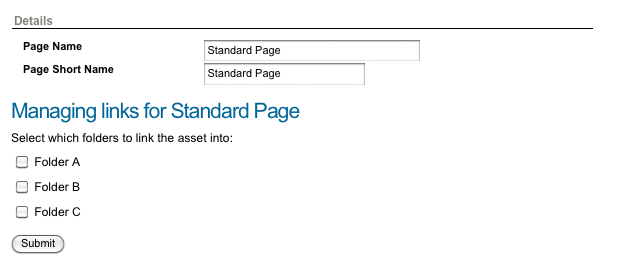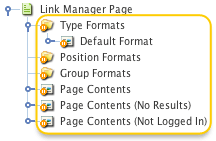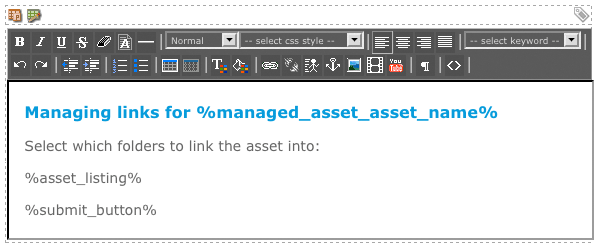Link Manager Page
Last Updated: 17 Dec 2015
The Link Manager Page allows a user to link an asset under a number of different assets. For example, you can set up a Link Manager Page to allow a user to link a Standard Page under a number of different Folders in your Site.
Bookmarks to the headings on this page:
The figure below shows the Details screen of a Standard Page in the Simple Edit Interface. At the bottom of the screen, the user can select which Folders to link this asset into. This list is created using a Link Manager Page.

A Link Manager Page on the Simple Edit Interface
Once your Link Manager Page is created, you can configure its settings on its associated asset screens. The majority of these screens are the same or similar to those for a Standard Page and an Asset Listing Page and are described in either the Asset Screens manual or the Asset Listing manual. In this chapter, we will describe the Details screen, which is different for a Link Manager Page.
Additional Dependant Assets

Additional dependant assets
When you create a Link Manager Page, several assets are automatically created beneath it, as highlighted in the figure to the right. You can use these assets to define the contents and layout of the Link Manager Page.
- Type Formats: this folder contains a Default Format Bodycopy that is used to define what information to display for each asset listed in the list on the Link Manager Page. When you select asset types in the Asset Types to List field on the Details screen, you can choose to customise the layout of each asset type on the Display Formats screen. When you do this, a Bodycopy named '<asset type> Format' is created in this folder. For example if you have added Standard Page assets to the Link Manager Page, and customised the format for Standard Page assets, a Bodycopy named Standard Page Format is added to this folder.
- Page Contents: this Bodycopy is used to define the overall layout of the Link Manager Page including where to put the list of assets, a heading for the page and an introduction about the page.
- Page Contents (No Results): this Bodycopy is used to define the overall layout of the Link Manager Page when there are no assets to show.
- Page Contents (Not Logged In): this Bodycopy is used to define the overall layout of the Link Manager Page if the user is not logged in.
For more information about the Position Formats and Group Formats folders, refer to the Asset Listing manual.
Details Screen
The Details screen of the Link Manager Page allows you to set up the page, including which assets to list and from what part of the system to list them from. For more information about the Status, Future Status,Thumbnail and Details section of the screen, refer to the Details Screen chapter in the Asset Screens manual. For more information on the Asset Selection, Asset Locations, List Formatting, Customise Bodycopies, List Position Settings, Dynamic Parameters, Structured Root Selector Options and Button Text, refer to the Asset Listing manual.
Linking
The Linking section of the Details screen is shown in the figure below.

The Linking section
This section allows you to specify the type of link to create and the asset that is to be linked. The fields available are as follows:
- Link Types: select what type of link to create the asset as. For example, if you want to hide the assets from the menu, select TYPE_2. The options that are available include TYPE_1, TYPE_2 and NOTICE. For more information on each of these link types, refer to the Asset Screens manual.
- Managed Asset: select the asset to be linked. If you using dynamic parameters, select the parent asset where the assets are stored. For example, if the Link Manager is being used for all assets in your Site, select your Site as the Managed Asset. If you leave this field blank, the users' user account asset will be used instead.
Advanced Settings
The Advanced Settings section of the Details screen is shown in the figure below.

The Advanced Settings section
This section controls where the form is submitted. This is useful if you nest a Link Manager Page into another page. By default, this option is set to The Current URL and the form is submitted to the current page you are viewing (i.e. the page in which the Link Manager Page is nested). This means that the success or error message for the Link Manager Page will be shown within the original nesting page. If you set this option to The Page's Own URL, the Link Manager Page will submit to its own URL. That means that the success or error message will not be nested in another page, because the user will be redirected to the Link Manager Page itself. The URL, lineage and menu etc will change to that of the Link Manager Page.
Default Format Bodycopy
The Default Format Bodycopy asset is used to define what information to display for all asset types listed in the list on the Link Manager Page. When you select asset types in the Asset Types to List field on the Details screen, you can choose to customise the layout of each asset type on the Display Formats screen. When you do this, a Bodycopy named '<asset type> Format' is created in the Type Formats Folder. For example if you have added Standard Page assets to the Link Manager Page, and customised the format for Standard Page assets, a Bodycopy named Standard Page Format is added to this folder. For more information on how to customise a particular asset type, refer to the Asset Listing manual.
An example Link Manager Page is shown in the figure below. For each asset listed, a check box and the name of the asset is being shown. This has been defined in the Default Format Bodycopy.

An example Link Manager Page
To change what information is being shown, right click on the Default Format Bodycopy in the Asset Map and select Edit Contents. Click on the ![]() icon – the WYSIWYG Editor will appear where you can use keyword replacements and formatting to layout the information to show on the page. By default, the information shown in the figure below will appear in the WYSIWYG Editor.
icon – the WYSIWYG Editor will appear where you can use keyword replacements and formatting to layout the information to show on the page. By default, the information shown in the figure below will appear in the WYSIWYG Editor.

The WYSIWYG Editor on the Default Format Bodycopy
Keyword Replacements on the Default Format Bodycopy
A list of keyword replacements is provided in the WYSIWYG Editor toolbar on the Edit Contents screen of the Default FormatBodycopy. You can use these keyword replacements in conjunction with text, images and links etc to layout what to show for each asset in the list.
Tip: If you do not include the keyword replacement Asset Selection (Linked) on the Default Format Bodycopy, the user will not be able to select an asset to link to.
The standard keyword replacements that are available include the following:
- Asset Selection (Linked): this will show a check box for the asset in the list. The user can select this box if they want to link the asset under it.
Please note, a number of other keyword replacements appear in the list. For more information about these keyword replacements, refer to the Concepts manual.
Page Contents Bodycopy
The Page Contents Bodycopy asset is used to define the overall layout of the Link Manager Page including where to put the list of assets, a heading for the page and an introduction about the page. For example, for the Link Manager Page shown in the figure below, the title of the page, a brief description about the page, the list of assets and the submit button is being shown. This has been defined in the Page Contents Bodycopy.

An example Link Manager Page
To change what information is being shown, right click on the Page Contents Bodycopy in the Asset Map and select Edit Contents. Click on the ![]() icon – the WYSIWYG Editor will appear where you can use keyword replacements and formatting to layout the information to show on the page. By default, the information shown in the figure below will appear in the WYSIWYG Editor.
icon – the WYSIWYG Editor will appear where you can use keyword replacements and formatting to layout the information to show on the page. By default, the information shown in the figure below will appear in the WYSIWYG Editor.

The WYSIWYG Editor on the Page Contents Bodycopy
Keyword Replacements on the Page Contents Bodycopy
A list of keyword replacements is provided in the WYSIWYG Editor toolbar on the Edit Contents screen of the Page Contents Bodycopy. You can use these keyword replacements in conjunction with text, images and links etc to layout what to show for the Link Manager Page.
Tip: If you do not include the keyword replacements Asset Listing and Submit Button on the Page Contents Bodycopy, the list of assets will not appear and the user will not be able to link the asset.
The standard keyword replacements that are available include the following:
- Asset Listing: this will show the list of assets. If you do not include this keyword replacement, the list will not appear on the page.
- Asset Selection Check All (Linked): this will show a check box. When the user selects this box, all assets in the list will be selected. The managed asset will then be linked under all assets in the list.
- The list of error messages: this will show any error messages that may occur when the user attempts to link an asset.
- The list of success messages: this will show the messages that occur when the user successfully links an asset.
- The ID of the managed asset: this will show the asset id of the asset that is being linked.
- Managed Asset Name: this will show the name of the asset that is being linked.
- Managed Asset Type: this will show the asset type of the asset that is being linked.
- Short name of the managed asset: this will show the short name of the asset that is being linked.
Please note, a number of other keyword replacements appear in the list. For more information about the keyword replacements for the managed asset, refer to the Concepts manual. For all other keyword replacements, refer to the Keyword Replacements manual.
Page Contents (No Results) Bodycopy
The Page Contents (No Results) Bodycopy is used to define the overall layout of the Link Manager Page when there are no assets to show. To change what information is being shown, right click on the Bodycopy in the Asset Map and select Edit Contents. Click on the ![]() icon – the WYSIWYG Editor will appear where you can use keyword replacements and formatting to layout the information to show on the page. By default, the information shown in the figure below will appear in the WYSIWYG Editor.
icon – the WYSIWYG Editor will appear where you can use keyword replacements and formatting to layout the information to show on the page. By default, the information shown in the figure below will appear in the WYSIWYG Editor.

The WYSIWYG Editor on the Page Contents (No Results) Bodycopy
Keyword Replacements on the Page Contents (No Results) Bodycopy
A list of keyword replacements is provided in the WYSIWYG Editor toolbar on the Edit Contents screen of the Page Contents (No Results)Bodycopy. You can use these keyword replacements in conjunction with text, images and links etc to layout what to if there are no assets to list. The standard keyword replacements available are the same as those that are available for the Page Contents Bodycopy.
Page Contents (Not Logged In) Bodycopy
The Page Contents (Not Logged In) Bodycopy asset is used to define the overall layout of the Link Manager Page if the user is not logged in. For example, for the Link Manager Page shown in the figure below, a message is shown informing the user that the page is not available to public users. This has been defined in the Page Contents (Not Logged In) Bodycopy.

An example Link Manager Page (Not Logged In)
To change what information is being shown, right click on the Page Contents (Not Logged In) Bodycopy in the Asset Map and select Edit Contents. Click on the ![]() icon – the WYSIWYG Editor will appear where you can use keyword replacements and formatting to layout the information to show on the page. By default, the information shown in the figure below will appear in the WYSIWYG Editor.
icon – the WYSIWYG Editor will appear where you can use keyword replacements and formatting to layout the information to show on the page. By default, the information shown in the figure below will appear in the WYSIWYG Editor.

The WYSIWYG Editor on the Page Contents (Not Logged In) Bodycopy
Keyword Replacements on the Page Contents (Not Logged In) Bodycopy
A list of keyword replacements is provided in the WYSIWYG Editor toolbar on the Edit Contents screen of the Page Contents (Not Logged In)Bodycopy. You can use these keyword replacements in conjunction with text, images and links etc to layout what to if there are no assets to list. The standard keyword replacements available are the same as those that are available for the Page Contents Bodycopy.
